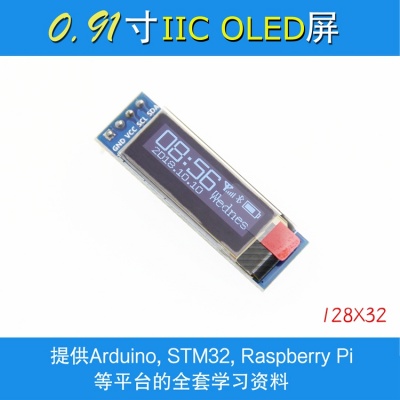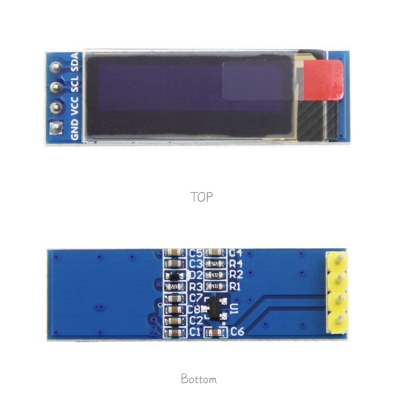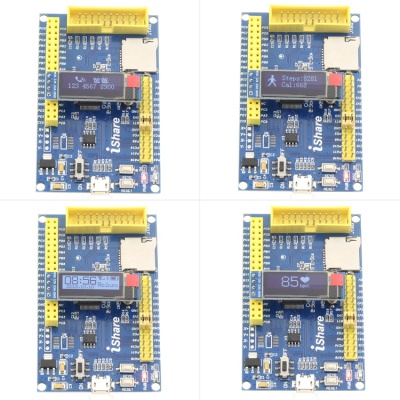Difference between revisions of "0.91inch IIC OLED Module SSD1306 SKU:MC091GX"
(→Product Parameters) |
(→Interface Definition) |
||
| Line 80: | Line 80: | ||
==<font color="blue">Interface Definition</font> == | ==<font color="blue">Interface Definition</font> == | ||
| − | [[File: | + | [[File:MC091GX_001.jpg|550px]] |
| − | |||
| − | |||
| − | |||
{| class="wikitable" border="1" style="width: 550px; background-color: white;" | {| class="wikitable" border="1" style="width: 550px; background-color: white;" | ||
| − | | align="center" | | + | | align="center" |模块标号 |
| − | | align="center" | | + | | align="center" |说明 |
| − | |||
|- | |- | ||
| − | |||
| − | |||
| − | |||
| − | |||
| − | |||
| − | |||
| − | |||
| − | |||
| − | |||
| − | |||
| − | |||
| − | |||
| − | |||
| − | |||
| − | |||
| − | |||
| − | |||
| − | |||
| − | |||
| − | |||
| − | |||
| − | |||
| − | |||
| − | |||
| − | |||
| − | |||
| − | |||
| − | |||
| − | |||
| − | |||
| − | |||
| − | |||
| − | |||
| − | |||
| − | |||
| − | |||
| − | |||
| − | |||
| − | |||
| − | |||
| − | |||
| − | |||
| − | |||
| − | |||
| − | |||
| − | |||
| − | |||
| − | |||
| − | |||
| − | |||
| − | |||
| − | |||
| − | |||
| − | |||
| − | |||
| − | |||
| − | |||
| − | |||
| − | |||
| − | |||
| − | |||
| − | |||
| − | |||
| − | |||
| − | |||
| − | |||
| − | |||
| − | |||
| − | |||
| − | |||
| − | |||
| − | |||
| − | |||
| − | |||
| − | |||
| − | |||
| − | |||
| − | |||
| − | |||
| − | |||
| − | |||
| − | |||
| − | |||
| − | |||
| − | |||
| − | |||
| − | |||
| − | |||
| − | |||
| − | |||
| align="center" |GND | | align="center" |GND | ||
| + | | align="center" |OLED显示模块电源地 | ||
|- | |- | ||
| − | | align="center" | | + | | align="center" |VCC |
| − | | align="center" | | + | | align="center" |OLED显示模块电源正(3.3V/5V) |
| − | |||
| − | |||
| − | |||
| − | |||
| − | |||
| − | |||
| − | |||
| − | |||
| − | |||
| − | |||
| − | |||
| − | |||
| − | |||
| − | |||
| − | |||
| − | |||
| − | |||
|- | |- | ||
| − | | align="center" | | + | | align="center" |SCL |
| − | | align="center" | | + | | align="center" |OLED显示模块IIC总线时钟信号 |
| − | |||
|- | |- | ||
| − | | align="center" | | + | | align="center" |SDA |
| − | | align="center" | | + | | align="center" |OLED显示模块IIC总线数据信号 |
| − | |||
|- | |- | ||
|} | |} | ||
Revision as of 11:55, 25 July 2019
Contents
Product Picture
Product Description
- 0.91 inch OLED screen with black and white or black and blue color display
- 128x32 resolution for clear display and high contrast
- Large viewing angle: greater than 160° (one screen with the largest viewing angle in the display)
- Wide voltage supply (3V~5V), compatible with 3.3V and 5V logic levels, no level shifting chip required
- With IIC bus, only a few IOs can be used to light up the display
- Ultra-low power consumption: normal display is only 0.06W (far below the TFT display)
- Military-grade process standards, long-term stable work
- Provides a rich sample program for STM32, C51, Arduino, and Raspberry Pi platforms
- Provide underlying driver technical support
Product Parameters
| 名称 | 参数 |
| 显示颜色 | 白色/蓝色 |
| SKU | MC091GW/MC091GB |
| 尺寸 | 0.91(inch) |
| 类型 | OLED |
| 驱动芯片 | SSD1306 |
| 分辨率 | 128*32 (Pixel) |
| 模块接口 | IIC interface |
| 有效显示区域(AA区) | 22.384x5.584(mm) |
| 触摸屏类型 | 无触摸屏 |
| 触摸IC | 无触摸IC |
| 模块PCB底板尺寸 | 12.00x38.00(mm) |
| 视角 | >160° |
| 工作温度 | -20℃~60℃ |
| 存储温度 | -30℃~70℃ |
| VCC电源电压 | 3.3V~5V |
| 功耗 | 待定 |
| 产品重量(含包装) | 5g |
Interface Definition
| 模块标号 | 说明 |
| GND | OLED显示模块电源地 |
| VCC | OLED显示模块电源正(3.3V/5V) |
| SCL | OLED显示模块IIC总线时钟信号 |
| SDA | OLED显示模块IIC总线数据信号 |
How to use on STM32 development board
This module is compatible with the ALIENTEK STM32 development board. The specific usage is as follows:
- Step 1: Download the test program
- Download the STM32 test program from the Program Download column
- For a description of the relevant test procedures, please refer to the test program documentation in the package
- Step 2: Connect the STM32 development board
- Find the TFTLCD Slot on the development board, connect the module pins and Slot(For example, the module CS pin corresponds to the slot CS pin),
- and then plug them directly into the Slot
- Step 3: Compile and download the program to the development board
- Compile and download the program you need to test to the STM32 development board( Don't know how to compile and download?)
- Step 4: Observe the running of the program
- After the program is finished, observe the running status of the program. If it can be displayed normally, the program runs successfully.
Program Download
Product Documentation
- 3.5inch 16bit Parallel-Port Module User Manual
- 3.5inch TFTLCD Specification
- 3.5inch 16bit Parallel-Port Module Size Picture
- 3.5inch 16bit Parallel-Port Module Schematic
- 3.5inch 16bit Parallel-Port Module LCD Schematic and PCB Package Library
- Driver IC ILI9486 Data sheet
Reference Materials
- C51 Keil and stc-isp software use illustration
- STM32 keil software use illustration
- PCtoLCD2002 software use illustration
- Image2Lcd software use illustration
- Chinese and English display modulo settings



